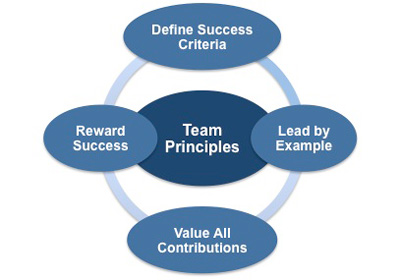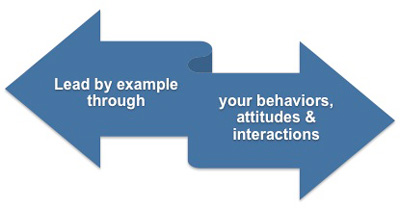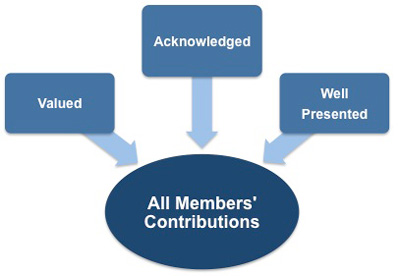The Principles of Team Building
There has been a lot of academic study of teams and team building over the years and much of it has found its way into team building books aimed at managers. As a result, there are certain aspects of team building that have gained the status of 'Golden Rules' that you should follow in order to build and manage a successful team.
A good example of this is team size. Academic studies have shown that the ideal team size is between five and nine, with six being the ideal number.
 |
The effect of team size on productivity can be traced back to the work of Maximilian Ringelmann, a French agricultural engineer born in 1861. He discovered that the more people who pulled on a rope, the less effort each individual contributed, despite the total force generated by the group rising.
This effect became obvious after there were about five people on the rope. Ringelmann attributed this to what he called 'social loafing.' This happens because working as part of a group or team tends to obscure the lack of individual effort.
The impact of social loafing is more significant where each team member is performing exactly the same mundane task. With this type of task it is very difficult for anyone to tell how much effort any one individual is putting in and very difficult to reward an individual, or give that person a sense of achievement. Not surprisingly, this results in individuals putting in as little effort as they think they can get away with.
As well as Ringelmann's work, there have been innumerable studies involving team-building programs and a large number of companies that have designed games specifically to test the factors affecting team cohesion, trust, and cooperation as well as the quality of the work done by various teams. The ideal team size to achieve the objectives set by these exercises seems to be around five or six.
This evidence does appear to be slightly more compelling than the Ringelmann experiment, but you should remember that the tasks set in this type of exercise are often designed with a fairly small group in mind. This leads to the circular logic that:
'Tasks designed to be completed by small groups are most efficiently completed by small groups.'
No doubt many of these academic studies have been performed rigorously and the results and findings are both valid and enlightening. Unfortunately, they are of little use to a manager or team leader working in the real world, where team size is usually something over which the manager has little control.
The reality for most team leaders and project managers is that the team size is dictated by the amount of work to be done and the time available. In a cross-functional project team, the size of the team is dictated by the functions that need to be represented. In either case, 95% of the time you will need to make the best of the team that you are given because the size and composition is something that you will not have much control over.
Similarly, you may have very little control over team rewards because some of the team members may not be under your direct control, remuneration may be decided at a higher management level, or you may be constrained by organizational policy.
All of this means that successful team building in the workplace has more to do with applying some basic principles to the team you have been given, rather than recruiting 'perfect' team members in order to build an ideal team from scratch.
The four principles of team building are:
 |
Define Success Criteria
The first principle is to define and communicate the team objective. This should be easily understood by everyone and allow all members to contribute, regardless of their skills and experience.
For a project team, success criteria will be defined in the project plan and it will be obvious on a week-by-week basis whether or not the project is on track. In addition, team members will be able to compare their progress with their individual work schedule. This means that project teams seldom have problems in this particular area.
However, with other types of team, the objective is not always so clear and team members who feel as though they do not have a definite objective can easily become demotivated. There may also be a problem if the success criteria have been set at unrealistic levels and the team cannot 'buy into' them. This often happens when people who do not appreciate the day-to-day realities of the task have set the goals. This Team Briefing Checklist walks you through the process of preparing a team briefing.
Remember, success cannot be achieved unless the team actually knows what it looks like.
Lead by Example
In many instances, your team members will have more technical knowledge and more experience than you do. This is not a problem: leadership has more to do with 'soft skills' than technical ones. Having said that, you may need some technical skills - for example, knowledge of a project management methodology if you are running a project team. However, no amount of technical expertise will make up for poor leadership skills.
Leading by example means exhibiting the same professional behaviors to everyone you interact with, whether they are inside or outside your team. This includes customers and suppliers as well as other people within your organization.
It can be tempting to allow your frustration with people outside the team to show in your comments or body language during team meetings and in conversations with individual team members. You should always make a concerted effort not to show a lack of respect in this way, even if you feel it is justified.
Demonstrating the type of behaviors you expect from your team in your own interactions communicates your expectations of how your team members should behave towards you and everyone else they come into contact with. If you can ensure that everyone on your team demonstrates respect towards customers, suppliers, and others who are not part of the team then this can prevent a lot of problems from taking root. There is always a tendency for teams to blame problems on those outside of the team and to ignore their own responsibilities. This is made easier for the team if there is an existing 'us and them' sentiment.
 |
As part of your time management ensure that you allocate time to communicate and monitor your team informally. For example, on your way back from getting a coffee, ask members of your team how things are going and listen carefully to their responses. Listen for omissions and look for negative body language. Many potential problems can be caught early by paying attention to what team members do not say as well as what they do say.
By utilizing both formal and informal contact time with your team you will be more likely to pick up on underlying issues and resolve them before they become serious.
Value All Contributions
Many teams will be significantly larger than the ideal of five to nine people, which can make it difficult to recognize each person's contribution.
You will need to show that you value each member of the team and that their views matter to you regardless of the role they play. One simple way to exhibit this is by ensuring all views are heard when talking about issues at a team meeting or discussion.
 |
You should use your 'Chair' skills during these events to ensure that everyone who wants to voice an opinion feels as though they will get a fair hearing. When people feel as though their opinions are unwelcome the most common response is to withdraw from the discussion and then seek out others who feel the same way. This leads to the formation of cliques and sub-groups that can be difficult to deal with once they have formed. The best way to prevent this type of team fragmentation is to make sure that everyone feels involved. If you have don't have much experience in chairing a meeting then you can download the 'Chairing a Meeting' eBook from this website.
Reward Group Success
As a manager, you will usually have the ability to reward those team members you are directly responsible for. However, the extent to which you are able to offer truly motivating rewards, especially monetary, will be influenced by your organization's culture and the amount of decision-making power you have.
There may be some team members who are not part of the organization (e.g. contract or freelance staff). In these cases you will need to think carefully about how to reward their efforts in a meaningful way. One way of doing this is to make it clear that you will try to help them to secure more work from your organization. Most contractors and freelancers place a high value on continuity of employment and would consider being recommended for other projects within your organization as the equivalent of a monetary reward.
Whilst these things are helpful in terms of each individual, it offers no opportunity for you as the manager to reward the whole team. As the complexity and diversity of organizations increase many organizations are beginning to make provisions for team-based rewards, but this is still far from normal.
 |
In situations where you are unable to offer a tangible reward you will have to seek ways to recognize the contribution and efforts of your team. This recognition can take many forms and can be large or small in relation to the achievement:
- Specific mention in your management report that you read to them.
- Mention of your team's achievement at the next divisional meeting. (This may mean for some teams that not everyone will be present on such an occasion, but the members will know that their efforts have been accredited.)
- Persuading a board member, senior customer contact, or someone they respect to acknowledge the team's contribution in an email or report, or if appropriate a visit to the team.
- Personal praise for the whole team in recognition of its efforts from you as their manager.
- Organize a social event. This can be as simple as taking everyone out for a meal at lunchtime. The amount of money you spend is far less important than the fact that you do 'something' even if it is fairly low-key.
It is important that the recognition is in proportion to the achievement attained, otherwise it will be seen as arbitrary and could have a negative effect on the morale of the team as a whole.
You may also be interested in:
Team Building in the Workplace | Different Types of Teams | Project Team Example | Support Team Example | Steering Team Example.



